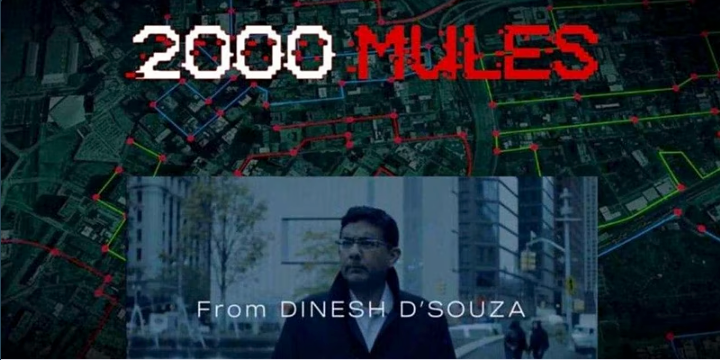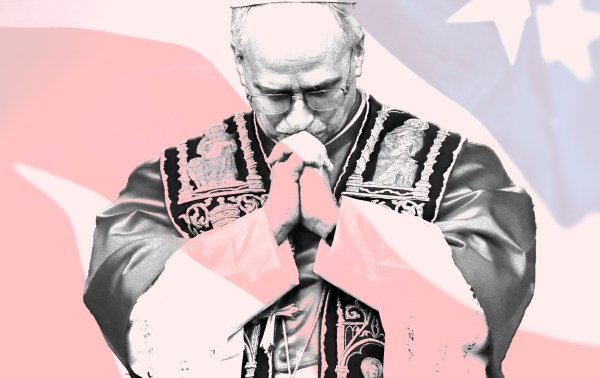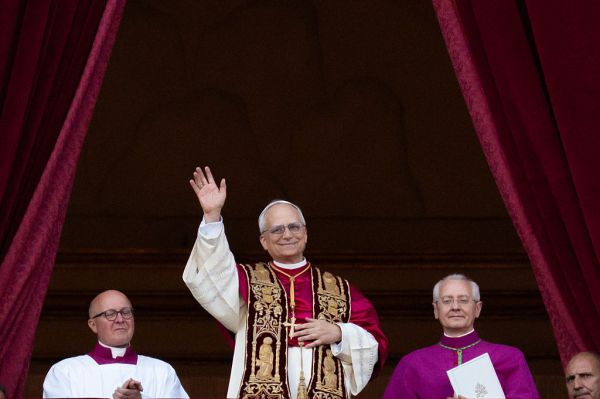On May 7, 2,000 Mules, a documentary film from right-wing provocateur Dinesh D’Souza, debuted in more than 270 theaters across the country. The movie, which grossed more than $1 million on the streaming service Rumble in under 12 hours, purports to have used cell phone geolocation data and video surveillance of mail-in ballot drop boxes to argue that President Joe Biden lost the 2020 election.
D’Souza has a history of promoting false and misleading claims and has also received a presidential pardon from Donald Trump for a felony conviction for making illegal campaign contributions.
The basic premise of the 90-minute film is that 2,000 “mules” or “paid professional operatives” delivered “fraudulent and illegal votes” to mail-in drop boxes in Michigan, Pennsylvania, Wisconsin, Arizona, and Georgia. The film supposedly uncovers an “elaborate network” of “mules” in key states that would have changed the outcome of the 2020 election. The evidence in question comes from conservative Texas-based organization True the Vote, founded by Catherine Engelbrecht. Throughout the movie, D’Souza interviews Engelbrecht as well as Gregg Phillips, a True the Vote board member, who is described as “having a deep background in election intelligence,” and explains the cell phone geolocation data on which True the Vote bases its claims.
The movie, however, is riddled with errors and previously debunked claims of voter fraud, and it’s based on a faulty premise.
The film opens with a once-viral video clip and meme of Biden saying: “We have put together I think the most extensive and inclusive voter fraud organization in the history of American politics.” Biden was not announcing his intent to commit voter fraud, as previous fact-checks have noted. Instead, he was describing efforts to prevent voter fraud and voter suppression.
The quote dates to Biden’s October 2020 appearance on the Pod Save America podcast hosted by Jon Lovett and Dan Pfeiffer. At one point during the interview, Pfeiffer asked Biden a two-part question related to voting in the then-upcoming presidential election:
“Part one, what’s your message to the folks who have not yet voted or do not have a plan to vote? And part two, for the folks who have already voted—50 million Americans who have already voted—what can they do, over the last 10 days, to help make sure that you’re the next president of the United States?”
In response, Biden shared resources for those who hadn’t yet voted and said, “Republicans are doing everything they can to make it harder for people to vote, especially people of color to vote. So, go to iwillvote.com.”
Biden continued: “Secondly, we’re in a situation where we have put together, and you guys did it for our administration, President Obama’s administration before this, we have put together I think the most extensive and inclusive voter fraud organization in the history of American politics. What the president is trying to do is discourage people from voting by implying that their vote won’t be counted, it can’t be counted, we’re going to challenge it and all these things.”
The “voter fraud organization” in question refers to efforts to prevent voter fraud and voter suppression, which Biden believed was coming from Trump, as he previously noted.
A spokesperson for the Biden campaign confirmed to the New York Times that Biden was indeed discussing efforts to prevent voter fraud. The Biden campaign’s national press secretary, TJ Ducklo, said at the time: “We have assembled the most robust and sophisticated team in presidential campaign history to confront voter suppression and fight voter fraud however it may present itself,” the New York Times reported.
The deceptively edited video flips his meaning and in doing so sets the tone for what’s to come.
D’Souza spends a considerable amount of time arguing that Trump was winning key states and that Biden pulling ahead overnight on election night was suspicious. But the numbers have an explanation.
In Wisconsin, for example, as we have reported, there was indeed a spike in votes for Biden from November 3 to November 4. But as the Milwaukee Journal Sentinel reported, Milwaukee County’s approximately 170,000 absentee votes—which were tabulated overnight—mostly went to Biden. Prior to the counting of those absentee ballots, the Journal Sentinel reported, Trump was in the lead by more than 100,000 votes. Mail-in ballots often favored Democrats, in part because Trump had spent months before the election warning his supporters not to use mail-in voting. Election experts and some Republicans expressed concern that these warnings would diminish mail-in votes for Republicans. When those votes were counted later in the process they sometimes caused significant bumps in Biden’s vote count. This is not evidence of voter fraud.
D’Souza also claims True the Vote has identified 2,000 “mules” who harvested enough votes to change the outcome of the 2020 election.
True the Vote claims it bought cell phone geolocation data (which is indeed available for purchase either from cell phone providers or from third-party data aggregators), from October 1, 2020, through November 3, 2020, in the five states that would have determined the outcome of the election.
The basic idea is this: True the Vote claims that through anonymized geolocation cell phone data, it identified “mules” who visited multiple mail-in ballot boxes and stuffed ballot boxes with stacks of ballots.
How did True the Vote identify these “mules”? If your cell phone geolocation data showed that you had gone near 10 or more ballot drop boxes and near one or more unnamed nonprofit organizations (referred to as a ballot “stash house” in the movie), between October 1 through November 3, you were considered a “mule.”
Ballot harvesting occurs when a third party collects and returns absentee or mail-in ballots on behalf of voters. Many states allow third parties to deliver ballots, David Becker, the executive director and founder of the nonpartisan Center for Election Innovation and Research explained to The Dispatch Fact Check. “That’s entirely legal. The vast majority are family members and caregivers.”
As of May 17, 2022, 31 states explicitly allow someone other than the voter to return a completed ballot on someone else’s behalf, per the National Conference of State Legislatures. Among these 31 states, however, states may have different provisions related to who is authorized to do so. Sixteen states permit a voter to designate someone other than a family member, household member, or caregiver, to return a ballot on their behalf.
“Historically, the Democratic Party has been more aggressive in pursuing the absentee vote, including developing ballot harvesting strategies,” says Douglas Jones, a professor of computer science and election expert at the University of Iowa. “Where it’s legal, of course the Republicans have been doing it too, but in recent years, the shady sounding term ‘ballot harvesting’ has been used, almost entirely on the Republican side, to allege that Democrats have been engaging in fraud.”
Here’s how the verification process works in Arizona, specifically. In an email to The Dispatch Fact Check, Benny White, an elections expert in Tucson, explained that a “harvested” ballot is verified the same way any early ballot or mail-in ballot is verified. “The signature is visually verified by election staff in the Recorder’s office; they do this by comparing the signature on the affidavit envelope with a signature of record on file with the Recorder,” he says. “If verified, the ballot affidavit envelope is forwarded to the elections department where an election board opens the affidavit envelope, removes the ballot and store[s] the empty envelope with other election materials.”
If, however, the signature cannot be verified, according to Arizona law, election officials must attempt to contact the voter and allow five working days for voters to verify their signature, White said. “If the envelope is not signed at all, election officials attempt to contact the voter and get the matter cleared up by the closing of the polls on Election Night.”
Here’s what’s important to keep in mind, outside of the specific case of Arizona. Even if a vote is illegally harvested in a state where harvesting is illegal, but the vote itself has not been tampered with in any way (i.e. it is signed and sealed) the vote itself would still be considered a legitimate legal vote.
In the film, D’Souza relies on surveillance footage supposedly showing “mules” dropping off ballots at drop boxes. But the footage doesn’t show this. The biggest issue, as Garrett Archer, data analyst at ABC15 in Phoenix and former senior elections analyst at the Arizona secretary of state’s office points out, is that we don’t see any surveillance footage of the “mules” going to drop boxes more than once.
An example: D’Souza and True the Vote focus on one particular “mule” from North Carolina who allegedly went to the ballot box multiple times and had been identified in a number of locations. But we only see surveillance footage of her at one location for the entirety of the movie. Engelbrecht and Phillps, in an interview with D’Souza, say it’s suspicious that this particular woman is wearing gloves, which can be seen in the video surveillance footage.
It’s easy to understand why some might regard such behavior as suspicious. But, as the Washington Post points out, in the context of the COVID-19 pandemic, many people wore gloves and masks as health precautions. As he does throughout the film, D’Souza chooses the most nefarious explanation of an event as the only possible explanation without bothering to explain why other plausible explanations must be ruled out.
Engelbrecht and Phillps also claim that the woman in the video surveillance footage put a “small stack” of ballots, “maybe three, maybe four” into the drop box at once. The issue, though, as the Washington Post puts it, is that it’s “not at all clear that the woman is putting more than one ballot in the box. There’s just one thin white rectangle that gets slipped into the box.” Phillips at one point, during the same scene, says that “we have her in a number of locations.” But again there’s no way to prove that she was in a “number of locations.”
(True the Vote did not respond to The Dispatch Fact Check’s request for comment.)
D’Souza’s theory hinges on cell phone geolocation data revealing the alleged plot for “mules” to stuff the ballot drop boxes. But the geolocation data isn’t the smoking gun D’Souza says it is.
Jones explained how location data works: “The commercially available cell phone location data you can buy is harvested from cell phone apps that the phone user authorizes to have access to their location information.”
The most obvious problem, according to David Becker, the executive director and founder of the nonpartisan Center for Election Innovation and Research, is that the ballot drop boxes, by definition, are placed in high-traffic areas. So, if someone goes to a library or a store near a drop box twice a day, their cell phone data may make them look like a “mule” under True the Vote’s criteria with no way to prove otherwise.
“You have no way of knowing whether this geolocation data represents phones going to a library, a drop box, a store,” Becker says. “We just have no idea where these folks are going to.”
Cell phone data, says Jones, “cannot show that a person dropped ballots in the box, only that they passed in its vicinity. It would be really difficult to use it to distinguish between someone who walked by on the sidewalk and someone who stopped and dropped in a ballot or two.”
Also, it’s worth mentioning that in September 2021, per the Atlanta Journal-Constitution, Georgia Republican Party Chairman David Shafer and True the Vote alleged that “GPS data identified 279 cell phones that had made multiple trips to within 100 feet of ballot drop boxes between Oct. 1 and Jan. 5.” But the head of the Georgia Bureau of Investigation determined there wasn’t enough evidence to pursue an investigation.
There are also legitimate reasons why a person might take multiple ballots to a drop box. “Depending on state law, there are legitimate reasons for a person to take multiple ballots to a drop box. Disabled people who vote by mail may rely on someone to help take their voted ballot to mail or to a drop box,” explained Jones. “The rules about this vary from state to state. In some states, it would be legal for a staff member at a retirement center to deliver ballots from residents to a drop box.”
There are still other problems with the geolocation conspiracy as presented in the film. The Washington Post reported that the geolocation maps purported to represent the cell phone geolocation pings are misleading too, noting that one of the maps in the film is actually a stock photo of Moscow.
True the Vote has even gone so far as to suggest that its data is so accurate it’s helped solve a murder case.
At one point in the movie, Engelbrecht and Phillips explain to D’Souza that True the Vote chose to “validate” the geolocation methodology by looking at an Atlanta murder case that Engelbrecht described as “ebbing on cold case status.” The “cold case” in question was the murder of Secoriea Turner in July 2020. True the Vote purchased cell phone geolocation data from the vicinity of the shooting and based on the data, according to Phillips, they “could see visually there were only a handful of unique devices that could possibly have pulled the trigger.” Phillips goes on to say that he then turned this information over to the FBI.
But the case was never a “cold case,” as the Washington Post reported. One suspect turned himself in in July 2020 and was arrested; a second suspect was arrested in August 2021.
More problematic: The suggestion from True the Vote that its methodology had helped solve the case isn’t true. NPR reports: “True The Vote acknowledged it had contacted law enforcement more than two months later, meaning it played no role in those arrests or indictments.”
D’souza, after hearing Phillips and Engelbrecht describe their supposed involvement in the case, says “this parallels exactly the work you’re doing with the mules.”
If you have a claim you would like to see us fact check, please send us an email at factcheck@thedispatch.com. If you would like to suggest a correction to this piece or any other Dispatch article, please email corrections@thedispatch.com.







Please note that we at The Dispatch hold ourselves, our work, and our commenters to a higher standard than other places on the internet. We welcome comments that foster genuine debate or discussion—including comments critical of us or our work—but responses that include ad hominem attacks on fellow Dispatch members or are intended to stoke fear and anger may be moderated.
With your membership, you only have the ability to comment on The Morning Dispatch articles. Consider upgrading to join the conversation everywhere.